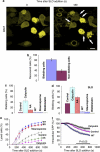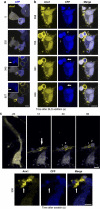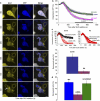Blebbing confers resistance against cell lysis
- PMID: 20596076
- PMCID: PMC3131879
- DOI: 10.1038/cdd.2010.81
Blebbing confers resistance against cell lysis
Abstract
The plasma membrane constitutes a barrier that maintains the essential differences between the cytosol and the extracellular environment. Plasmalemmal injury is a common event during the life of many cells that often leads to their premature, necrotic death. Blebbing - a display of plasmalemmal protrusions - is a characteristic feature of injured cells. In this study, we disclose a previously unknown role for blebbing in furnishing resistance to plasmalemmal injury. Blebs serve as precursors for injury-induced intracellular compartments that trap damaged segments of the plasma membrane. Hence, loss of cytosol and the detrimental influx of extracellular constituents are confined to blebs that are sealed off from the cell body by plugs of annexin A1 - a Ca(2+)- and membrane-binding protein. Our findings shed light on a fundamental process that contributes to the survival of injured cells. By targeting annexin A1/blebbing, new therapeutic approaches could be developed to avert the necrotic loss of cells in a variety of human pathologies.
Figures







Similar articles
-
Tailored protection against plasmalemmal injury by annexins with different Ca2+ sensitivities.J Biol Chem. 2011 May 20;286(20):17982-91. doi: 10.1074/jbc.M110.187625. Epub 2011 Mar 21. J Biol Chem. 2011. PMID: 21454475 Free PMC article.
-
P2X7 receptors mediate resistance to toxin-induced cell lysis.Biochim Biophys Acta. 2014 May;1843(5):915-22. doi: 10.1016/j.bbamcr.2014.01.024. Epub 2014 Jan 31. Biochim Biophys Acta. 2014. PMID: 24487066
-
Down-regulation of acid sphingomyelinase and neutral sphingomyelinase-2 inversely determines the cellular resistance to plasmalemmal injury by pore-forming toxins.FASEB J. 2019 Jan;33(1):275-285. doi: 10.1096/fj.201800033R. Epub 2018 Jul 6. FASEB J. 2019. PMID: 29979630
-
Dealing with damage: plasma membrane repair mechanisms.Biochimie. 2014 Dec;107 Pt A:66-72. doi: 10.1016/j.biochi.2014.08.008. Epub 2014 Aug 27. Biochimie. 2014. PMID: 25183513 Review.
-
Plasma membrane repair and cellular damage control: the annexin survival kit.Biochem Pharmacol. 2011 Mar 15;81(6):703-12. doi: 10.1016/j.bcp.2010.12.027. Epub 2011 Jan 8. Biochem Pharmacol. 2011. PMID: 21219882 Review.
Cited by
-
Caveolin-3 prevents swelling-induced membrane damage via regulation of ICl,swell activity.Biophys J. 2022 May 3;121(9):1643-1659. doi: 10.1016/j.bpj.2022.04.001. Epub 2022 Apr 2. Biophys J. 2022. PMID: 35378081 Free PMC article.
-
Annexins as Overlooked Regulators of Membrane Trafficking in Plant Cells.Int J Mol Sci. 2017 Apr 19;18(4):863. doi: 10.3390/ijms18040863. Int J Mol Sci. 2017. PMID: 28422051 Free PMC article. Review.
-
Small Pore-Forming Toxins Different Membrane Area Binding and Ca2+ Permeability of Pores Determine Cellular Resistance of Monocytic Cells.Toxins (Basel). 2021 Feb 9;13(2):126. doi: 10.3390/toxins13020126. Toxins (Basel). 2021. PMID: 33572185 Free PMC article.
-
Modulation of Microglial Function by ATP-Gated P2X7 Receptors: Studies in Rat, Mice and Human.Cells. 2024 Jan 16;13(2):161. doi: 10.3390/cells13020161. Cells. 2024. PMID: 38247852 Free PMC article. Review.
-
News about non-secretory exocytosis: mechanisms, properties, and functions.J Mol Cell Biol. 2019 Sep 19;11(9):736-746. doi: 10.1093/jmcb/mjy084. J Mol Cell Biol. 2019. PMID: 30605539 Free PMC article. Review.
References
-
- McNeil PL, Steinhardt RA. Plasma membrane disruption: repair, prevention, adaptation. Annu Rev Cell Dev Biol. 2003;19:697–731. - PubMed
-
- McNeil PL, Kirchhausen T. An emergency responce team for membrane repair. Nat Rev Mol Cell Biol. 2005;6:499–505. - PubMed
-
- Walport MJ. Complement. Second of two parts. N Engl J Med. 2001;344:1058–1066. - PubMed
-
- Parker MW, Feil SC. Pore-forming protein toxins: from structure to function. Prog Biophys Mol Biol. 2005;88:91–142. - PubMed
-
- Keefe D, Shi L, Feske S, Massol R, Navarro F, Kirchhausen T, et al. Perforin triggers a plasma membrane-repair response that facilitates CTL induction of apoptosis. Immunity. 2005;23:249–262. - PubMed
Publication types
MeSH terms
Substances
LinkOut - more resources
Full Text Sources
Other Literature Sources
Molecular Biology Databases
Miscellaneous

